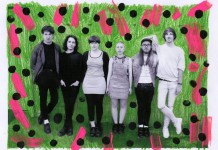As we’re ushered to our seats inside what’s now one of Bristol’s premier concert halls, built as a church in 1823, we look towards the small stage. Soft light glints off a biblical fresco of golden rays, and from three saxophones, waiting in their stands. My plus-one and I share a look that says we’re in for something special.
And we’re not wrong. Soon, horn player Colin Stetson walks on stage, offering a humble nod and smile to the welcoming crowd before picking up the largest, the bass saxophone. It’s almost as big as he is, but he handles it effortlessly, and, after another grin, the noise begins.
It’s immediately obvious that this venue was the perfect choice for the American saxophonist who has worked with Bon Iver, Arcade Fire and Lou Reed, along with releasing solo albums to critical acclaim. The hall’s incredible acoustics perfectly echo his cacophonous wall of drone. By using circular breathing techniques, and frankly, some sort of musical magic, Stetson manages to sound like a whole ensemble. A number of microphones catch percussive taps and even vocal howls right down the body of the instrument.
There’s a hypnotic quality to the endless, fast-paced sound, and my mind immediately begins to wander. I can’t help but get lost in time-lapse images of nature and wild, barren landscapes, of glaciers sped up and clouds thundering across skies – something very slow and fundamental yet constant and frenetic, all at the same time.
After the first number, he takes a well-deserved short break, explaining in his warm and friendly Michigan accent that this is new material, and unsurprisingly, his muscles are still getting used to the process. “It kinda hurts,” he laughs, stretching his fingers out, “Who’da thunk it, huh?”
He moves from the bass to the alto saxophone (which looks like a baby in comparison) and then tenor, again thoroughly shaping them to his musical will – there’s no battle here, he is in full and absolute control. The athleticism and talent required leaves us feeling as though we’re truly watching a modern maestro in action.
Stetson constantly changes, swaps and sculpts tempos and rhythms, leaving the listener unable to predict what will happen next, unlike the regularity of electronic beats that we’ve become used to. But it’s not uncomfortable or jarring, and it’s certainly not lofty self-indulgence. It’s somehow raw, moving and ultimately very personal. The encore demanded by the small but vocal audience is testament to that.
Check out ‘The Rest of Us’ right here:





